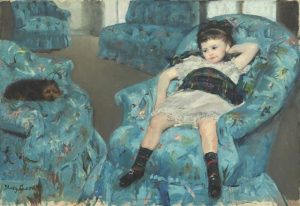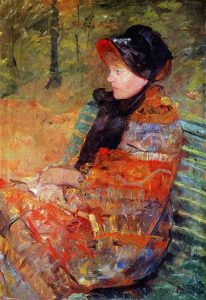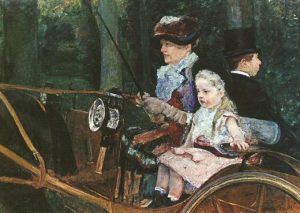Mary Cassatt is one of the female Impressionist and Feminist artists.
Little Girl in a Blue Armchair, 1878
National Gallery of Art, Washington D.C.
Permanent collection ©Artsy
Mary Stevenson Cassatt (May 22, 1844 in the United States – June 14, 1926 in France) born into a comfortable middle-class family. The Cassatt’s lived in France and Germany from 1851 to 1855, giving little Mary early exposure to European art and culture. Her childhood is little known, and it has been speculated that she may have visited the Paris World’s Fair of 1855, where she saw the art of Gustave Courbet. Jean-Baptiste-Camille Corot, Eugène Delacroix, and Jean-Auguste-Dominique Ingres, among other French masters. In 1860, at the age of 16, Cassatt began two years of study at the Pennsylvania Academy of the Fine Arts. In 1865, she begged her parents to let her continue to study art abroad. Despite initial doubts, they agreed, and she moved to Paris and studied with Jean-Léon Gérôme. After a brief return to the United States from 1870 to 1871, while frustrated by the lack of resources and artistic opportunities, she was on her way to Paris again. In the early 1870s, she also travelled to Spain, Italy, and the Netherlands, where she became acquainted with the work of artists such as Diego Velázquez, Peter Paul Rubens, and Antonio da Correggio. Until 1874, Cassatt had set up a studio in Paris; her family frequently modelled her work in the late 1870s and 1880s, which contains many pictures of contemporary women at the theatre and opera house, in gardens and living rooms. In 1877, when the artist Edgar Degas invited her to join the group of independent artists known as the Impressionists, she was pleased. Cassatt exhibited his work with the Impressionists in Paris from 1879 onwards and in 1886.
Young Mother and Two Children, 1908
White House Historical Association ©Artsy
Cassatt is primarily known for her sensitive depictions of mothers and children. Her portraits of women may have achieved such success for a particular reason. They respond to a societal need to idealize women’s domestic roles at a time when, in fact, many women have become interested in the right to vote, costume reform, higher education, and social equality. However, Cassatt’s depictions of upper-class and upper-class women were never simple; they contained layers of meaning behind the airy brushstrokes and bright colours of her Impressionist technique.
Téodor de Wyzewa wrote in an article in 1891: “Only women have the right to strictly practice the Impressionist system”. The art critic has stated that the French Impressionist style glorifies superficiality in an essential and not flamboyant, girly way. He went on to say that: “She alone can limit her efforts to interpreting impressions.” Other art critics who joined de Wyzewa’s chorus belittled the Impressionists for a new art form that they considered limited women’s abilities rather than the honed skills of men.
Portrait of Mlle C. Lydia Cassatt, 1880 @Wikiart
A group of independent artists to organize exhibitions outside the aesthetic system of the Paris Institute has been established. The Impressionists were really radical, and they weren’t easy for critics to like. They prioritized studying the effect of light on small-scale works mainly drawn in Plein air with pure colors represented by soft brushstrokes and breakdown. Instead of yearning for a grand historical picture – then considered the pinnacle of artistic achievement – the Impressionists, with their myriad perspectives on contemporary Paris, argue that modern life is itself a worthy subject.
This focus on classic themes has helped open doors for female artists. Traditionally, women were often prevented from drawing historical pictures, because the necessary knowledge of human anatomy was considered too ambitious for a woman. Instead, they tend to draw less formal works illustrating everyday life, a subject that has become synonymous with Impressionism. Indeed, this was one of the first art movements to have women as founding members.
A woman and child in the driving seat,1881
Philadelphia Museum of Art, Philadelphia, PA, US ©Wikiart
However, only five women participated in the entire series of eight Impressionist exhibitions (two of them used pseudonyms and joined only once). Other female artists studied and applied the Impressionist style but were officially excluded from the movement. She is considered one of seven artists who strictly exercised the “right to practice the Impressionist system” for women.
Synthetic
Sources:






